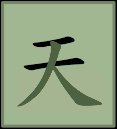天 tiān (sky, heaven, destiny, nature, etc.)
This term has many meanings in both everyday Chinese language and Chinese philosophy. Fung Yulan (馮友蘭), a well-known twentieth-century scholar of Chinese philosophy, identified five distinct connotations of the term:1
- a "material" or "physical" sky, as in tiandi (天地) or the physical universe of 'Heaven and Earth';
- an anthropomorphic emperor of Heaven;
- destiny or fate, as in tianming (天命);
- nature, as employed by Xunzi (荀子);
- the moral order of the universe, as seen in the Constant Mean (中庸)
人 rén (person, people, humans)
合 hé (to join, to combine)
一 yī (one)
This term can be translated as "the 'oneness' of Heaven and man", "the 'unity' of Heaven and man", or more stylistically, "uniting Heaven and humanity", as it has been rendered here. In addition, the linkage between Heaven and nature in the term tian allows the natural environment to be given moral and ethical consideration by humans.
It is important to recognize that this 'oneness' of Heaven and humanity is indeed a Confucian concept. It is often attributed to Daoist thought alone. Perhaps this is due to the common belief that Confucianism is largely a humanist and anthropocentric school of thought. To the contrary, as emphasized by some Confucian scholars, it is rather anthropocosmic. Whereas the tradition is generally focused on the establishment of a harmonious society through the cultivation of human relationships, it also incorporates Heaven and Earth into the formation of an ultimate harmony.2 This "dynamic triad" of Heaven, Earth, and humanity highlights the interconnectedness among them. Therefore according to this belief, human beings are able to participate in transforming the universe along with Heaven and Earth.3
According to Words to Live By《揚雄法言》written by the Confucian scholar Yang Xiong (揚雄), one must understand the relationships within this triumverate in order to be considered Confucian:
-
通天、地、人曰儒,通天、地而不通人曰伎。4
- Rough translation: "One who fully understands Heaven, Earth, and humanity is called a 'Ru' (Confucian). One who fully understands Heaven, Earth, but not humanity is called 'clever'."
 But if there is one individual in a Confucian society that must align Haven, Earth, and humanity, it is the king, or wang (王). This becomes apparent upon analysis of this character. The Shuowen Jiezi 《說文解字》, the first Chinese dictionary to analyze and explain the etymology of Chinese characters, offers the following analysis for wang:5
But if there is one individual in a Confucian society that must align Haven, Earth, and humanity, it is the king, or wang (王). This becomes apparent upon analysis of this character. The Shuowen Jiezi 《說文解字》, the first Chinese dictionary to analyze and explain the etymology of Chinese characters, offers the following analysis for wang:5
-
天下所歸往也
- Rough translation: "That to which 'all under heaven' reverts."
-
董仲舒曰古之造文者三畫而連其中謂之王三者天地人也而參通之者王也
- Rough translation: "Dong Zhongshu said: 'The one who created ancient writing; that which connects the three strokes is called "wang"; these three strokes represent Heaven, Earth, and man; the one who joins them is wang.'"
-
孔子曰一貫三為王凡王之屬皆從王
- Rough translation: "Confucius said: 'The one that passes through the three is wang; everything in the material world is subordinate to wang.'"
As the teachings of Confucius gained greater acceptance after his death, the Master acquired a title of 'uncrowned king', or suwang (素王). He was also considered to be a sage, or shengren (聖人). Throughout Confucian texts, there are numerous references to the sage - a master of the Confucian curriculum who embodies its teachings with his every word and action. Such a person is believed to have the ability to align Heaven, Earth, and humanity in harmony and rule the empire with great ease. Although Confucius did not explicitly refer to the concept of tian ren he yi, he frequently voiced his admiration for the sage, a title that he believed he did not deserve, and the relationship of the sage with Heaven. In the following passage about Yao (堯), a famous sage he greatly admired, Confucius indicates that one is able to model himself after Heaven, thus the unity between them:
- 子曰:“大哉,堯之為君也!巍巍乎!唯天為大,唯堯則之。蕩蕩乎!民無能名焉。巍巍乎!其有成功也;煥乎,其有文章!”《論語 · 泰伯》6
- "The Master said, 'Great was Yao as a prince! How exalted! There is no greatness like that of Heaven, yet only Yao could take it as a model.'" - The Analects, "Tai Bo"7
Although tian ren he yi was not part of Confucius' teachings, this concept was devloped by later Confucians. The Constant Mean 《中庸》, which is attributed to Confucius' grandson, elaborates on the theory:
-
萬物并育而不相害,道并行而不相悖。8
- "All things exist together, and they do not do harm to each other; all ways exist together, and they do not come into conflict."9
This 'oneness' of Heaven and humanity is essential in understanding the environmental implications of Confucian thought. This concept rectifies the misonception that Confucianism is a purely humanistic, anthropocentric tradition. Although the cultivation of human relationships to establish a harmonious society are a main concern of Confucians, it is within the context of a greater whole that includes Heaven and Earth. On this foundation, one may begin to look at Confucianism through an environmental perspective.
Endnotes
[1] Fung, Yu-lan. History of Chinese Philosophy. Vol. 1. Princeton, NJ: Princeton University Press, 1952. 31.
[2, 7, 9] Li, Tianchen. “Confucian Ethics and the Environment.” Culture Mandala: The Bulletin of the Centre for East-West Cultural
and Economic Studies: Vol. 6: Iss. 1, Article 4. 2003. 1. <http://epublications.bond.edu.au/cm/vol6/iss1/4>.
Cambridge, MA: Harvard University Press, 1998. xxxvii.
[4] Chinese Text Project. "The Junzi."《君子卷第十二》Yang Xiong's 'Words to Live By'.《揚雄法言》
<http://ctext.org/yangzi-fayan/juan-shi-er>.
[5] Shuowen Jiezi 《說文解字》. Richard Sears, ed. Chinese Etymology. <http://www.chineseetymology.org>.
[6] Chinese Text Project. "Tai Bo." The Analects.《論語 · 泰伯》<http://ctext.org/analects/tai-bo>.
[8] Chinese Text Project. Zhong Yong.《中庸》<http://ctext.org/liji/zhong-yong>.


